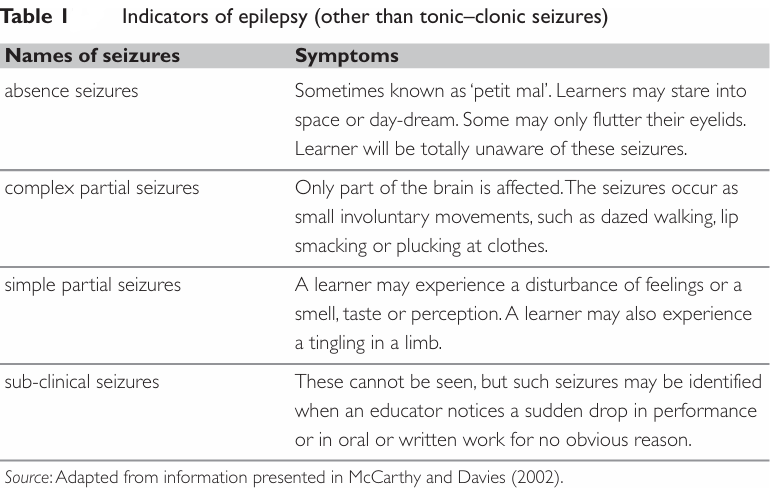


 Grammar
Grammar
 Tenses
Tenses
 Present
Present
 Past
Past
 Future
Future
 Parts Of Speech
Parts Of Speech
 Nouns
Nouns
 Verbs
Verbs
 Adverbs
Adverbs
 Adjectives
Adjectives
 Pronouns
Pronouns
 Pre Position
Pre Position
 Preposition by function
Preposition by function 
 Preposition by construction
Preposition by construction
 Conjunctions
Conjunctions
 Interjections
Interjections
 Grammar Rules
Grammar Rules
 Linguistics
Linguistics
 Semantics
Semantics
 Pragmatics
Pragmatics
 Reading Comprehension
Reading Comprehension
 Teaching Methods
Teaching Methods|
Read More
Date: 2025-03-22
Date: 2025-03-27
Date: 2025-03-25
|
Epilepsy
Epilepsy is a neurological disorder that affects 1 in 200 of the population.
Epilepsy is an established tendency to recurrent seizures, which occur as a result of biochemical changes in the brain. It affects children of all ages, backgrounds and levels of ability. It is not an illness or disease, but is indicative of a physical disorder. (McCarthy and Davies, 1996)
If a child only has one seizure this would not necessarily indicate epilepsy. Epilepsy means that the child has recurring seizures. The symptoms and duration vary greatly depending on the type of epilepsy, but also it affects children in different ways. Epilepsy is abnormal brain functioning and this produces fits, attacks or seizures. Children may have muscle spasms, convulsions, involuntary movements and changes in perception and consciousness. These seizures are usually over in a few seconds or minutes, the same processes that caused the seizures having triggered other mechanisms in the brain stopping them.
The Tonic–Clonic Seizures, previously known as ‘grand mal’ epilepsy, are the most disturbing for all involved and indeed can be quite frightening not only for the child experiencing the seizure, but also for other pupils and adults. In this situation the child may make a noise and then fall quite suddenly, followed by convulsive jerks. Saliva around the mouth may then start appearing and some-times bladder or bowel control might be lost. Within a few minutes the child will regain consciousness, but is quite likely to feel dazed and confused for a few hours, very tired with the possibility of a headache developing.
If this is not the first time a child experiences a seizure it is not considered a medical emergency. However, a child may have caused harm to himself when he fell or may have been unconscious for quite a long time. If this is the case, it is always better to seek medical attention.
The other types of epilepsy are not so easily identified, but as one in three of the children with epilepsy fall behind academically, it is essential that educators are aware of signs that MAY indicate a neurological disorder. Table 1 in illustrates the type of epilepsy and some of the symptoms.

Discussion
As has been mentioned, learners with epilepsy experience seizures in many different ways. Can you think of a learner who may possibly be experiencing a form of epilepsy?
|
|
|
|
لشعر لامع وكثيف وصحي.. وصفة تكشف "سرا آسيويا" قديما
|
|
|
|
|
|
|
كيفية الحفاظ على فرامل السيارة لضمان الأمان المثالي
|
|
|
|
|
|
|
قسم التربية والتعليم يطلق الامتحانات النهائية لمتعلِّمات مجموعة العميد التربوية للبنات
|
|
|